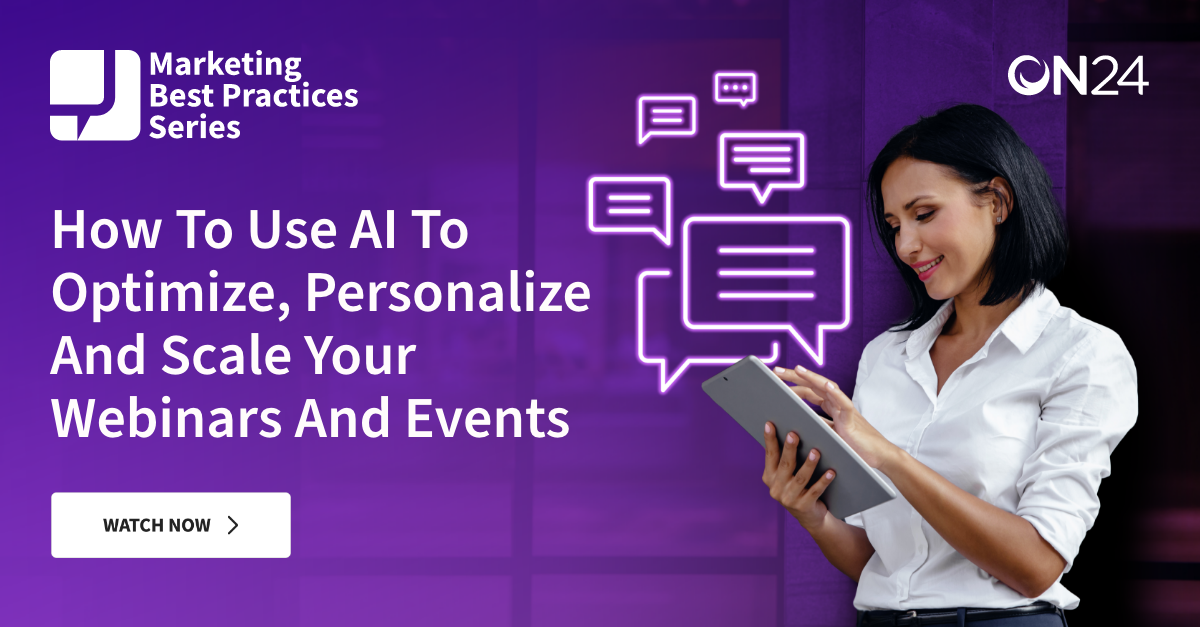The Ultimate Guide to Personalization and Segmentation in B2B Marketing

Within B2B marketing, we often use terms without thinking about them or what they actually mean in our work. The classic example is when someone talks about a “lead” — do they mean a person’s name or company, or do they mean a relevant and qualified contact at a target account?
Furthermore, even when we have agreed definitions, as B2B marketers we are often too busy to stop and ask ourselves — why? When we know that, then we can then reflect on the how — and whether we need to change how we are doing our B2B marketing.
Personalization and segmentation are two areas that are worth reflecting on. Read on to learn what these two terms mean, why they are so important for B2B marketers and how you can use them in your marketing efforts.
What do personalization and segmentation mean for B2B marketers?

It’s difficult to distill these two important terms down to a sentence each, but here are two definitions that B2B marketers can use to understand personalization and segmentation:
-
- Personalization refers to the practice of tailoring marketing strategies, content and messaging to the specific needs, preferences and pain points of individual buyers and businesses.
- Segmentation refers to the process of dividing a broad market into smaller, more specific groups of buyers and businesses, based on shared characteristics, such as industry, company size, location or buying behavior.
In practice, this means personalization follows segmentation, making effective segmentation a prerequisite for effective personalized marketing.
Why is personalization essential today?

Based on millions of B2B buyer interactions, the data in ON24’s Digital Engagement Benchmarks report shows that personalization is no longer a “nice to have.”
Some key findings include:
-
- Personalization resulted in doubled conversion rates for meetings booked.
- Personalized experiences saw a 68% increase in engagement with calls-to-action, compared to 8% across webinars as a whole.
- Year-over-year, the increase in demo requests was almost 4X higher, while growth within non-personalized webinars was 56%.
The reason for these dramatic differences is simple: buyers respond far more positively to personalized and relevant marketing. Indeed, research from Forrester and Adobe found that two-thirds of B2B buyers expected the same or better personalization in their professional lives vs. their personal lives. A study by ON24 and Heinz Marketing revealed a similar picture, with 65% expecting highly personalized experiences.
More to the point, the ON24 Digital Engagement Benchmarks report suggests that even if your organization isn’t personalizing its marketing, your competitors are probably already doing so, as the use of key personalization tactics on the ON24 platform grew exponentially through the final quarter of 2023.
But there’s an even bigger reason to make personalization essential — the growth of generative AI means that companies are set to increase the volume of personalized content dramatically.
According to BCG, 67% of CMOs are planning to use AI to personalize experiences in 2024. Separately, a study from LinkedIn shows that more than half (51%) of B2B marketers plan to use Generative AI to create optimized and engaging content that resonates with target audiences.
So, if you are reading this and aren’t already doing personalization, these studies should make it clear: personalization is essential and for you and other marketers, the trends make it critical to change how you engage.
Why are first-party data and segmentation needed for effective personalization?

As mentioned above, personalization follows segmentation. But to effectively do segmentation, you need data — and the most potential comes from first-party data.
First-party data enables accurate segmentation and more effective personalization by being collected and controlled by your organization alone. By its nature, none of your competitors will have the same first-party data, allowing B2B marketers to create uniquely personalized experiences.
Not only that, but using first-party data for personalization creates a feedback loop of data. Using insights from first-party data to personalize digital experiences makes for better interactions, which promote more engagement. That engagement not only powers your pipeline, but it also means marketers will have even more first-party data on their buyers to create even better personalization and more effective experiences.
But another critical element is that first-party data is far more likely to be available in real-time. In the context of segmentation, today’s marketers are more likely to build segments that are dynamic — in that contacts and accounts enter and leave given segments based on their real-time behaviors, preferences and interactions, allowing marketers to respond quickly and effectively to evolving buyer needs.
As an example, this means that the moment someone shifts from one stage of the buying journey to another, the offers they see can change as they leave one segment and join another.
Furthermore, first-party data is essential to fuel the creation of personalized content and experiences through generative AI. At ON24, it’s this first-party data that makes our AI-powered Analytics and Content Engine (ACE) possible.
Examples of segments built with data
Data is essential to creating segments. Before you segment, you need to know some information about the buyer, such as contact title and business relationship. The stage of the funnel a buyer is in is another crucial piece of insight that goes a long way in segmenting an audience so buyers receive the content that is valuable for where they are in their buying process.
The table below displays various types of segments marketers may use to segment audiences for better personalization. Segments can be built with anything from a single item of data — say, just a funnel stage — or can be built based on multiple items of data.
In each case, where a buyer doesn’t fall into a particular segment — whether because of a lack of data, or because they don’t align exactly to a segment — the fallback acts as a default. These are the individuals you don’t have any data on and therefore don’t fall into any segment.
| Segment type | By funnel stage | By business relationship | By contact title | By account vertical | By region | By customer registration field |
| Segment 1 | Awareness | Customer | CXO | Technology | NA | Pick list |
| Segment 2 | Consideration | Prospect | VP/Director | Professional Services | EMEA | Check box |
| Segment 3 | Selection | Partner | Manager | Life Sciences | APAC | Text |
| Fallback | Awareness | Prospect | Manager | Horizontal | Global | Custom |
Once you’ve got your segmentation nailed down, offers, content and experiences can be created tailored to these segments. Being more relevant and targeted, the content and experiences are far more likely to drive engagement and conversions because you’ve addressed the buyer’s needs. More engagement also means you’ll be gaining even more first-party data which will give you even further insights on your buyers.
Also, if you are reading this as an ON24 customer, it’s easy to both create segments and target them with personalized offers and content through Segment Builder, as seen in the clip taken from a recap of ON24 Next below:
Three tips for personalization through segmentation

Here are three ideas to try out to personalize your own B2B marketing efforts.
#1: Personalize calls-to-action by funnel stage
Typically, you will have your leads and contacted assigned by funnel stage or lead score within your marketing automation platform. If that’s not the case, at the very least, they will be assigned by whether they are a customer or a prospect.
Expanding the table shared earlier to include both prospective and existing customers, we could segment across the entire customer lifecycle to deliver different CTAs in line with our goals for each segment.
| Segment name | Funnel stage | Your goal | Examples of personalized CTA offers |
| Early-stage / TOFU | Awareness | Get the buyer to realize they have a problem. | Beginner’s guide e-book
Trends webinar. |
| Mid-stage / MOFU | Consideration | Prove to the prospect why and how our solutions is a good fit for their organization.
Get our solution onto their shortlist for the final decision. |
Download analyst buyer’s guide (e.g., Forrester Wave, Gartner Magic Quadrant).
Attend event with customer speakers sharing tips. Case studies. |
| Late-stage / BOFU | Selection | Give our buyer the right push and validation they need to move forward with our solution. | Sign up for a demo.
Book a meeting with sales. |
| Not yet engaged / onboarded | Customer Adoption | Ensure our customer is onboarded successfully, efficiently, and without friction.
Provide our customer with the right resources, materials, and guidance to ensure they have a positive experience with us. |
Link to customer hub or forum.
Live Q&A / office hours webinar. Book a training session or success call. |
| Engaged | Customer Engagement | Give our customer new ways to expand/renew their current contract.
Facilitate further engagement from our customers with our solution. |
Upsell offer — learn about new product or feature.
Attend customer summit or dinner. Need help? Contact us! |
| Champion | Customer Advocacy | Reward our customer’s loyalty and celebrate their achievements publicly.
Ask for referrals and testimonials. |
Share your success — speak at our event.
Refer a customer. Leave a review. |
| Likely to lapse | Customer Priority Renewal | Reduce risk of churn.
Secure renewal. |
Live Q&A / office hours webinar.
Book a call with an expert. Need help? Contact us! |
| Fallback | (No segment) | Identify prospect.
Assess buying intent. |
Link to content hub with multiple assets ordered by buying stage / intent. |
So, if a prospect is in the Awareness segment, they might be shown CTAs for a beginner’s guide e-book or a trends webinar. However, if they are further down the funnel in the Selection segment, CTAs for signing up for a demo or booking a meeting with sales would align with goals for that segment. Similarly, if a customer is in the Customer Advocacy segment, where the goal is to reward them for their loyalty and celebrate their achievements publicly, they might be shown CTAs for speaking at an event or to refer a customer.
In fact, chances are that you already have such segments identified within your marketing automation system or account-based marketing tools — making it easy to create CTAs specifically for each. For ON24 customers who are using Marketo or 6sense, segmentation data from there can also be mapped directly into Segment Builder, making it even easier to display relevant CTAs within your digital experiences.
#2: Personalize content offers for target accounts by function and keywords in job title
Usually, buyer data such as job level or seniority is captured early on due to the sales team wanting to identify decision-makers and influencers, especially when targeting high-value accounts. For an ABM strategy, targeted content hubs can be an excellent way to offer white-glove experiences.
However, even within a single account, different individuals have different needs. For example, an executive is likely to be concerned about cost and strategy. By contrast, end-users will want to know whether the solution will make their lives easier and enable them to be more effective. Even if the end-user is not the overall decision-maker, they are likely to be a significant influencer.
As an example, here is how a software company selling to marketers might target different audiences within key accounts.
| Segment name | Example data to build segment | Their needs | Examples of personalized content offer |
| CTO or CIO | Job function contains IT, Tech, Information or Dev
Title contains CTO, CIO or “Chief” |
Ensure any marketing technology is compliant with security.
Use Microsoft Entra as SSO. |
White paper on product’s data security benefits (e.g., ISO 27001 or SOC 2 Type 2 compliance). |
| CMO | Job function contains Marketing or Revenue
Title contains CMO or “Chief” |
Improve marketing’s digital maturity.
Lead the marketing function effectively. |
Marketing Maturity Assessment Tool
CMO Leadership Briefing |
| VP / Director of Sales | Job functions contain Sales or Revenue
Title contains Sales or “Business Development” |
Close more deals and revenue.
Convert more marketing leads. |
E-book on Converting Marketing Leads.
On-demand demo showing how marketing tech platform integrates with sales CRM. |
| Fallback | (No segment) | Identify prospect.
Assess buying intent. |
Marketing Best Practices Webinar |
#3: Personalize event invitations by region or geography
For this final example, here’s how ON24 recently personalized using segments. For the ON24 Next launch event, if attendees were based within traveling distance of one of ON24’s Engage 24 roadshow locations, they were offered an invite to attend on the console.
Other forms of segmentation were also present, including different offers depending on whether someone was a current customer or not.
But there are many other ways that location can be used, for example by offering the chance to connect with a local sales rep, or to download a report tailored for a particular market.
Summary recap

- Personalization is tailoring marketing to individual buyers and businesses, while segmentation is dividing the market into smaller groups based on shared characteristics.
- Personalization is essential because buyers respond more positively to relevant marketing, and competitors are already doing it (Source: ON24 Digital Engagement Benchmarks Report).
- First-party data is crucial for effective personalization because it is unique to your organization and provides real-time insights. It will become even more important as businesses use generative AI to create and scale personalized content.
- Three simple ways that B2B marketers can try now include:
- #1: Personalize calls-to-action by funnel stage;
- #2: Personalize content offers for target accounts by function and keywords in job title; and
- #3: Personalize event invitations by region or geography.
- Segment Builder provides an easy way for ON24 customers to target and deliver personalized content.
If you want to start improving how you personalize your experiences, change how you engage and drive more revenue, about ON24 change how you engage, see how the ON24 Intelligent Engagement Platform can help you.
